Evaluating the Accuracy and Spatial Agreement of Five Global Land Cover Datasets in the Ecologically Vulnerable South China Karst
Abstract
:1. Introduction
2. Materials and Methods
2.1. Study Area
2.2. Datasets
2.2.1. Global Land Cover Datasets
2.2.2. Reference Land Cover Datasets
2.2.3. Auxiliary Data
2.3. Methods
2.3.1. Legend Harmonization
2.3.2. Areal Comparison
2.3.3. Spatial Agreement Analysis
2.3.4. Accuracy Evaluation
2.3.5. Weighted Complexity of Land Cover
3. Results
3.1. Areal Comparison
3.2. Spatial Agreement Analysis
3.3. Accuracy Analysis
3.3.1. Overall Accuracy Analysis
3.3.2. Accuracy Evaluation by Province
3.3.3. Producer’s and User’s Accuracy
3.3.4. Overall Accuracy Evaluation under Different Elevations
3.3.5. Overall Accuracy Evaluation under Different Slopes
3.3.6. Accuracy Evaluation of Karst and Non-Karst Areas
4. Discussion
4.1. Comprehensive Evaluation of Five Recent Global Land Cover Datasets in the South China Karst
4.2. Impact of Landscape Heterogeneity on Dataset Accuracy
4.3. Suggestions for Future Global Land Cover Mapping
5. Conclusions
Author Contributions
Funding
Acknowledgments
Conflicts of Interest
Appendix A
| Year | Woodland | Shrubland | Grassland | Cropland | Wetlands | Urban | Permanent Snow and Ice | Bare Areas | Waterbodies | |
|---|---|---|---|---|---|---|---|---|---|---|
| CLUD | 2000 | 728,715 | 278,529 | 347,244 | 499,276 | 8768 | 25,409 | 897 | 16,190 | 31,200 |
| 2010 | 730,111 | 278,909 | 345,097 | 492,068 | 8861 | 31,623 | 896 | 16,255 | 32,436 | |
| 2015 | 727,777 | 278,437 | 344,843 | 486,813 | 9081 | 39,047 | 896 | 16,261 | 33,099 | |
| 2020 | 746,628 | 263,644 | 332,866 | 489,709 | 9263 | 46,412 | 988 | 14,525 | 34,519 | |
| CCI-LC | 2000 | 801,173 | 217,686 | 216,016 | 659,080 | 5571 | 11,078 | 1095 | 341 | 24,380 |
| 2010 | 804,229 | 206,879 | 213,141 | 659,747 | 5891 | 21,407 | 1095 | 299 | 23,733 | |
| 2015 | 804,551 | 205,416 | 213,042 | 656,971 | 5952 | 25,331 | 1095 | 298 | 23,764 | |
| 2020 | 836,207 | 170,856 | 210,989 | 660,716 | 4138 | 29,348 | 1005 | 134 | 20,990 | |
| MCD12Q1 | 2001 | 877,823 | 141,215 | 745,231 | 124,007 | 6669 | 26,314 | 249 | 8037 | 11,225 |
| 2010 | 883,985 | 160,063 | 719,713 | 121,566 | 6689 | 30,172 | 207 | 7101 | 11,267 | |
| 2015 | 903,530 | 172,551 | 701,537 | 104,934 | 8301 | 31,615 | 188 | 6736 | 11,375 | |
| GlobeLand30 | 2000 | 971,701 | 34,746 | 288,020 | 576,385 | 6163 | 20,670 | 2938 | 2836 | 32,497 |
| 2010 | 969,796 | 36,642 | 281,248 | 581,056 | 6272 | 24,115 | 2716 | 3749 | 30,430 | |
| 2020 | 977,680 | 24,512 | 247,871 | 588,570 | 5616 | 51,384 | 2347 | 4989 | 33,871 | |
| GlobCover | 2009 | 631,519 | 502,346 | 57,643 | 705,992 | 100 | 13,538 | 5721 | 4157 | 18,069 |
| CGLS-LC | 2015 | 1,269,967 | 24,200 | 177,423 | 380,114 | 8041 | 59,542 | 717 | 6051 | 16,063 |
| 2019 | 1,241,843 | 14,629 | 179,212 | 416,680 | 10,154 | 51,335 | 749 | 5342 | 18,203 |
| Sichuan | Hubei | Chongqing | Hunan | Yunnan | Guizhou | Guangxi | Guangdong | ||
|---|---|---|---|---|---|---|---|---|---|
| 2000 | CCI-LC | 53.4 | 59.5 | 49.7 | 57.0 | 39.7 | 34.9 | 51.3 | 58.2 |
| GlobeLand30 | 53.5 | 57.6 | 48.5 | 62.0 | 38.9 | 35.1 | 56.0 | 64.5 | |
| MCD12Q1 | 42.8 | 52.9 | 19.3 | 46.0 | 41.4 | 30.9 | 41.3 | 38.6 | |
| 2010 | CCI-LC | 53.3 | 59.6 | 49.8 | 54.9 | 39.9 | 35.2 | 51.3 | 58.1 |
| GlobCover | 34.0 | 47.3 | 43.9 | 46.6 | 35.5 | 35.0 | 44.9 | 50.1 | |
| GlobeLand30 | 53.5 | 57.8 | 48.6 | 61.6 | 38.3 | 35.6 | 55.5 | 64.1 | |
| MCD12Q1 | 42.6 | 54.5 | 20.0 | 45.0 | 41.4 | 30.9 | 42.0 | 39.0 | |
| 2015 | CCI-LC | 53.2 | 59.0 | 49.3 | 54.2 | 39.8 | 35.0 | 51.0 | 57.7 |
| CGLS-LC | 55.2 | 61.6 | 45.1 | 63.0 | 40.4 | 32.6 | 55.9 | 63.1 | |
| MCD12Q1 | 43.2 | 53.1 | 20.4 | 44.5 | 41.0 | 30.3 | 41.7 | 40.8 | |
| 2020 | CCI-LC | 52.6 | 56.6 | 53.6 | 50.9 | 41.3 | 33.4 | 47.0 | 50.6 |
| CGLS-LC | 56.6 | 61.1 | 54.5 | 63.0 | 40.3 | 31.3 | 51.1 | 60.0 | |
| GlobeLand30 | 53.3 | 54.6 | 51.7 | 55.6 | 40.8 | 32.0 | 48.5 | 53.9 | |
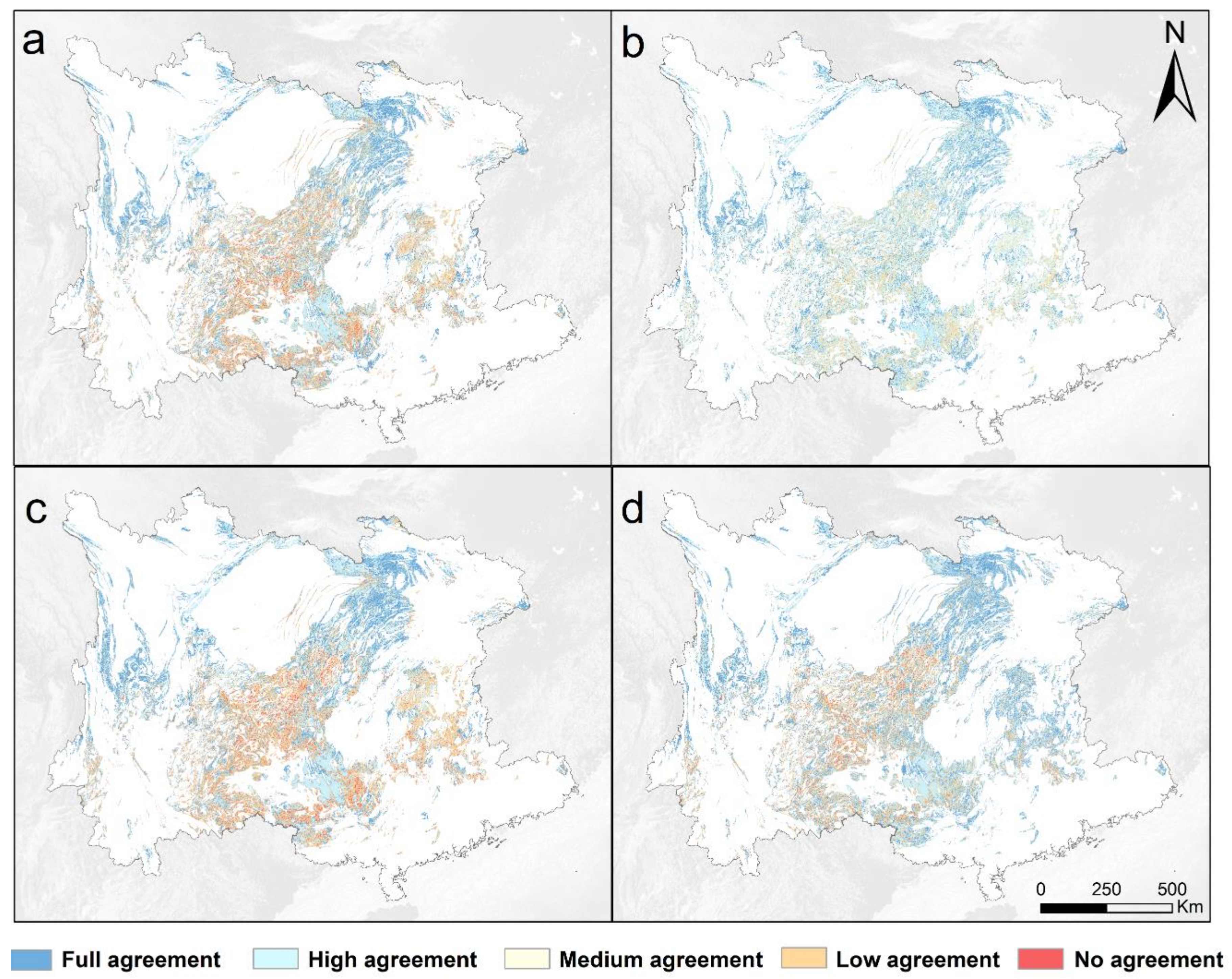
References
- Song, X.-P.; Hansen, M.C.; Stehman, S.V.; Potapov, P.V.; Tyukavina, A.; Vermote, E.F.; Townshend, J.R. Global land change from 1982 to 2016. Nature 2018, 560, 639–643. [Google Scholar] [CrossRef] [PubMed]
- Nguyen, L.H.; Joshi, D.R.; Clay, D.E.; Henebry, G.M. Characterizing land cover/land use from multiple years of Landsat and MODIS time series: A novel approach using land surface phenology modeling and random forest classifier. Remote Sens. Environ. 2020, 238, 111017. [Google Scholar] [CrossRef]
- Dosdogru, F.; Kalin, L.; Wang, R.Y.; Yen, H. Potential impacts of land use/cover and climate changes on ecologically relevant flows. J. Hydrol. 2020, 584, 124654. [Google Scholar] [CrossRef]
- Sterling, S.M.; Ducharne, A.; Polcher, J. The impact of global land-cover change on the terrestrial water cycle. Nat. Clim. Chang. 2013, 3, 385–390. [Google Scholar] [CrossRef]
- Zhang, Z.; Wang, X.; Zhao, X.; Liu, B.; Yi, L.; Zuo, L.; Wen, Q.; Liu, F.; Xu, J.; Hu, S. A 2010 update of National Land Use/Cover Database of China at 1:100000 scale using medium spatial resolution satellite images. Remote Sens. Environ. 2014, 149, 142–154. [Google Scholar] [CrossRef]
- Findell, K.L.; Berg, A.; Gentine, P.; Krasting, J.P.; Lintner, B.R.; Malyshev, S.; Santanello, J.A.; Shevliakova, E. The impact of anthropogenic land use and land cover change on regional climate extremes. Nat. Commun. 2017, 8, 989. [Google Scholar] [CrossRef]
- Friedl, M.A.; McIver, D.K.; Hodges, J.C.; Zhang, X.Y.; Muchoney, D.; Strahler, A.H.; Woodcock, C.E.; Gopal, S.; Schneider, A.; Cooper, A. Global land cover mapping from MODIS: Algorithms and early results. Remote Sens. Environ. 2002, 83, 287–302. [Google Scholar] [CrossRef]
- Friedl, M.A.; Sulla-Menashe, D.; Tan, B.; Schneider, A.; Ramankutty, N.; Sibley, A.; Huang, X. MODIS Collection 5 global land cover: Algorithm refinements and characterization of new datasets. Remote Sens. Environ. 2010, 114, 168–182. [Google Scholar] [CrossRef]
- Defourny, P.; Kirches, G.; Brockmann, C.; Boettcher, M.; Peters, M.; Bontemps, S.; Lamarche, C.; Schlerf, M.; Santoro, M. Land cover CCI. In Proceedings of the 3rd GOFC-GOLD Symposium, Wageningen, The Netherlands, 15–19 April 2013; Volume 2, p. 325. [Google Scholar]
- Bontemps, S.; Defournya, P.; Van Bogaert, E.; Weber, J.L.; Arino, O. GlobCorine—A joint EEA-ESA project for operational land dynamics monitoring at pan-European scale. In Proceedings of the 33rd International Symposium on Remote Sensing of Environment, Stresa, Italy, 4–8 May 2009. [Google Scholar]
- Chen, J.; Chen, J.; Liao, A.; Cao, X.; Chen, L.; Chen, X.; He, C.; Han, G.; Peng, S.; Lu, M. Global land cover mapping at 30 m resolution: A POK-based operational approach. ISPRS J. Photogramm. Remote Sens. 2015, 103, 7–27. [Google Scholar] [CrossRef] [Green Version]
- Marcel, B.; Bruno, S.; Luc, B.; Bert, D.R.; Myroslava, L.; Nandin-Erdene, T.; Linlin, L.; Tarko, A.J. Copernicus Global Land Service: Land Cover 100m: Version 3 Globe 2015–2019: Product User Manual; Laboratory of Geo-information Science and Remote Sensing: Wageningen, The Netherlands, 2020. [Google Scholar]
- Fritz, S.; See, L.; Rembold, F. Comparison of global and regional land cover maps with statistical information for the agricultural domain in Africa. Int. J. Remote Sens. 2010, 31, 2237–2256. [Google Scholar] [CrossRef]
- Foody, G.M. Assessing the accuracy of land cover change with imperfect ground reference data. Remote Sens. Environ. 2010, 114, 2271–2285. [Google Scholar] [CrossRef] [Green Version]
- Stehman, S.V.; Foody, G.M. Key issues in rigorous accuracy assessment of land cover products. Remote Sens. Environ. 2019, 231, 111199. [Google Scholar] [CrossRef]
- Zaldo-Aubanell, Q.; Serra, I.; Sardanyés, J.; Alsedà, L.; Maneja, R. Reviewing the reliability of Land Use and Land Cover data in studies relating human health to the environment. Environ. Res. 2021, 194, 110578. [Google Scholar] [CrossRef]
- Wang, K.; Zhang, C.; Chen, H.; Yue, Y.; Zhang, W.; Zhang, M.; Qi, X.; Fu, Z. Karst landscapes of China: Patterns, ecosystem processes and services. Landsc. Ecol. 2019, 34, 2743–2763. [Google Scholar] [CrossRef] [Green Version]
- National Forestry and Grassland Administration. China’s Third National Bulletin on Rocky Desertification; National Forestry and Grassland Administration: Beijing, China, 2018. [Google Scholar]
- Zhang, J.; Liu, M.; Liu, X.; Luo, W.; Wu, L.; Zhu, L. Spectral analysis of seasonal rock and vegetation changes for detecting karst rocky desertification in southwest China. Int. J. Appl. Earth Obs. Geoinf. 2021, 100, 102337. [Google Scholar] [CrossRef]
- Pei, J.; Wang, L.; Huang, N.; Geng, J.; Cao, J.; Niu, Z. Analysis of landsat-8 oli imagery for estimating exposed bedrock fractions in typical karst regions of southwest China using a karst bare-rock index. Remote Sens. 2018, 10, 1321. [Google Scholar] [CrossRef] [Green Version]
- Jiang, Z.; Lian, Y.; Qin, X. Rocky desertification in Southwest China: Impacts, causes, and restoration. Earth-Sci. Rev. 2014, 132, 1–12. [Google Scholar] [CrossRef]
- Pei, J.; Wang, L.; Wang, X.; Niu, Z.; Kelly, M.; Song, X.-P.; Huang, N.; Geng, J.; Tian, H.; Yu, Y. Time series of Landsat imagery shows vegetation recovery in two fragile karst watersheds in southwest China from 1988 to 2016. Remote Sens. 2019, 11, 2044. [Google Scholar] [CrossRef] [Green Version]
- Brandt, M.; Yue, Y.; Wigneron, J.P.; Tong, X.; Tian, F.; Jepsen, M.R.; Xiao, X.; Verger, A.; Mialon, A.; Al-Yaari, A. Satellite-observed major greening and biomass increase in south China karst during recent decade. Earths Future 2018, 6, 1017–1028. [Google Scholar] [CrossRef]
- Yue, Y.; Liao, C.; Tong, X.; Wu, Z.; Fensholt, R.; Prishchepov, A.; Jepsen, M.R.; Wang, K.; Brandt, M. Large scale reforestation of farmlands on sloping hills in South China karst. Landsc. Ecol. 2020, 35, 1445–1458. [Google Scholar] [CrossRef]
- Tong, X.; Brandt, M.; Yue, Y.; Ciais, P.; Rudbeck Jepsen, M.; Penuelas, J.; Wigneron, J.-P.; Xiao, X.; Song, X.-P.; Horion, S. Forest management in southern China generates short term extensive carbon sequestration. Nat. Commun. 2020, 11, 129. [Google Scholar] [CrossRef]
- Loveland, T.R.; Reed, B.C.; Brown, J.F.; Ohlen, D.O.; Zhu, Z.; Yang, L.; Merchant, J.W. Development of a global land cover characteristics database and IGBP DISCover from 1 km AVHRR data. Int. J. Remote Sens. 2000, 21, 1303–1330. [Google Scholar] [CrossRef]
- Gong, P.; Wang, J.; Yu, L.; Zhao, Y.; Zhao, Y.; Liang, L.; Niu, Z.; Huang, X.; Fu, H.; Liu, S. Finer resolution observation and monitoring of global land cover: First mapping results with Landsat TM and ETM+ data. Int. J. Remote Sens. 2013, 34, 2607–2654. [Google Scholar] [CrossRef] [Green Version]
- Hansen, M.C.; Potapov, P.V.; Moore, R.; Hancher, M.; Turubanova, S.A.; Tyukavina, A.; Thau, D.; Stehman, S.V.; Goetz, S.J.; Loveland, T.R. High-resolution global maps of 21st-century forest cover change. Science 2013, 342, 850–853. [Google Scholar] [CrossRef] [Green Version]
- Tsendbazar, N.-E.; De Bruin, S.; Fritz, S.; Herold, M. Spatial accuracy assessment and integration of global land cover datasets. Remote Sens. 2015, 7, 5804. [Google Scholar] [CrossRef] [Green Version]
- Yang, Y.; Xiao, P.; Feng, X.; Li, H. Accuracy assessment of seven global land cover datasets over China. ISPRS J. Photogramm. Remote Sens. 2017, 125, 156–173. [Google Scholar] [CrossRef]
- Hua, T.; Zhao, W.; Liu, Y.; Wang, S.; Yang, S. Spatial consistency assessments for global land-cover datasets: A comparison among GLC2000, CCI LC, MCD12, GLOBCOVER and GLCNMO. Remote Sens. 2018, 10, 1846. [Google Scholar] [CrossRef] [Green Version]
- Jokar Arsanjani, J. Characterizing and monitoring global landscapes using GlobeLand30 datasets: The first decade of the twenty-first century. Int. J. Digit. Earth 2019, 12, 642–660. [Google Scholar] [CrossRef]
- Liang, L.; Gong, P. Evaluation of global land cover maps for cropland area estimation in the conterminous United States. Int. J. Digit. Earth 2015, 8, 102–117. [Google Scholar] [CrossRef]
- Pérez-Hoyos, A.; Rembold, F.; Kerdiles, H.; Gallego, J. Comparison of global land cover datasets for cropland monitoring. Remote Sens. 2017, 9, 1118. [Google Scholar] [CrossRef] [Green Version]
- Shi, H.; Auch, R.F.; Vogelmann, J.E.; Feng, M.; Rigge, M.; Senay, G.; Verdin, J.P. Case study comparing multiple irrigated land datasets in arizona and colorado, USA. JAWRA J. Am. Water Resour. Assoc. 2018, 54, 505–526. [Google Scholar] [CrossRef]
- Sulla-Menashe, D.; Gray, J.M.; Abercrombie, S.P.; Friedl, M.A. Hierarchical mapping of annual global land cover 2001 to present: The MODIS Collection 6 Land Cover product. Remote Sens. Environ. 2019, 222, 183–194. [Google Scholar] [CrossRef]
- Chen, J. Remote Sensing Mapping of Global Land Cover; Science Press: Beijing, China, 2016. [Google Scholar]
- Sophie, B.; Pierre, D.; Eric, V.B.; ESA, T.; Olivier, A.; Vasileios, K.; Ramos, P.J. GLOBCOVER 2009 Products Description and Validation Report; Université Catholique de Louvain: Ottignies-Louvain-la-Neuve, Belgium, 2009. [Google Scholar]
- Buchhorn, M.; Smets, B.; Bertels, L.; De Roo, B.; Lesiv, M.; Tsendbazar, N.-E.; Herold, M.; Fritz, S. Copernicus Global Land Service: Land Cover 100m: Collection 3 Epoch 2015, Globe; Version V3. 0.1 [Data Set]; Copernicus Global Land Service: Brussels, Belgium, 2020. [Google Scholar]
- Buchhorn, M.; Smets, B.; Bertels, L.; De Roo, B.; Lesiv, M.; Tsendbazar, N.-E.; Herold, M.; Fritz, S. Copernicus Global Land Service: Land Cover 100m: Collection 3 Epoch 2019, Globe; Version V3. 0.1 [Data Set]; Copernicus Global Land Service: Brussels, Belgium, 2020. [Google Scholar]
- Liu, J.; Liu, M.; Tian, H.; Zhuang, D.; Zhang, Z.; Zhang, W.; Tang, X.; Deng, X. Spatial and temporal patterns of China’s cropland during 1990–2000: An analysis based on Landsat TM data. Remote Sens. Environ. 2005, 98, 442–456. [Google Scholar] [CrossRef]
- Deng, X.; Huang, J.; Rozelle, S.; Zhang, J.; Li, Z. Impact of urbanization on cultivated land changes in China. Land Use Policy 2015, 45, 1–7. [Google Scholar] [CrossRef]
- Liu, J.; Kuang, W.; Zhang, Z.; Xu, X.; Qin, Y.; Ning, J.; Zhou, W.; Zhang, S.; Li, R.; Yan, C. Spatiotemporal characteristics, patterns, and causes of land-use changes in China since the late 1980s. J. Geogr. Sci. 2014, 24, 195–210. [Google Scholar] [CrossRef]
- Zuo, L.; Zhang, Z.; Carlson, K.M.; MacDonald, G.K.; Brauman, K.A.; Liu, Y.; Zhang, W.; Zhang, H.; Wu, W.; Zhao, X. Progress towards sustainable intensification in China challenged by land-use change. Nat. Sustain. 2018, 1, 304–313. [Google Scholar] [CrossRef]
- Kuang, W.; Liu, J.; Dong, J.; Chi, W.; Zhang, C. The rapid and massive urban and industrial land expansions in China between 1990 and 2010: A CLUD-based analysis of their trajectories, patterns, and drivers. Landsc. Urban Plan. 2016, 145, 21–33. [Google Scholar] [CrossRef]
- Tian, H.; Wu, M.; Wang, L.; Niu, Z. Mapping early, middle and late rice extent using sentinel-1A and Landsat-8 data in the poyang lake plain, China. Sensors 2018, 18, 185. [Google Scholar] [CrossRef] [Green Version]
- Liang, L.; Liu, Q.; Liu, G.; Li, H.; Huang, C. Accuracy evaluation and consistency analysis of four global land cover products in the Arctic region. Remote Sens. 2019, 11, 1396. [Google Scholar] [CrossRef] [Green Version]
- Herold, M.; Mayaux, P.; Woodcock, C.; Baccini, A.; Schmullius, C. Some challenges in global land cover mapping: An assessment of agreement and accuracy in existing 1 km datasets. Remote Sens. Environ. 2008, 112, 2538–2556. [Google Scholar] [CrossRef]
- Foody, G.M. Status of land cover classification accuracy assessment. Remote Sens. Environ. 2002, 80, 185–201. [Google Scholar] [CrossRef]
- Comber, A.; Fisher, P.; Brunsdon, C.; Khmag, A. Spatial analysis of remote sensing image classification accuracy. Remote Sens. Environ. 2012, 127, 237–246. [Google Scholar] [CrossRef] [Green Version]
- Foody, G.M. What is the difference between two maps? A remote senser’s view. J. Geogr. Syst. 2006, 8, 119–130. [Google Scholar] [CrossRef]
- Bai, Y.; Feng, M.; Jiang, H.; Wang, J.; Zhu, Y.; Liu, Y. Assessing consistency of five global land cover data sets in China. Remote Sens. 2014, 6, 8739. [Google Scholar] [CrossRef] [Green Version]
- Giri, C.; Zhu, Z.; Reed, B. A comparative analysis of the Global Land Cover 2000 and MODIS land cover data sets. Remote Sens. Environ. 2005, 94, 123–132. [Google Scholar] [CrossRef]
- Ran, Y.; Li, X.; Lu, L. Evaluation of four remote sensing based land cover products over China. Int. J. Remote Sens. 2010, 31, 391–401. [Google Scholar] [CrossRef]
- Zeng, T.; Zhang, Z.; Zhao, X.; Wang, X.; Zuo, L. Evaluation of the 2010 MODIS collection 5.1 land cover type product over China. Remote Sens. 2015, 7, 1981. [Google Scholar] [CrossRef] [Green Version]
- Wu, W.; Shibasaki, R.; Yang, P.; Ongaro, L.; Zhou, Q.; Tang, H. Validation and comparison of 1 km global land cover products in China. Int. J. Remote Sens. 2008, 29, 3769–3785. [Google Scholar] [CrossRef]
- Smith, J.H.; Stehman, S.V.; Wickham, J.D.; Yang, L. Effects of landscape characteristics on land-cover class accuracy. Remote Sens. Environ. 2003, 84, 342–349. [Google Scholar] [CrossRef]
- Abdullah, A.M.; Masrur, A.; Adnan, M.S.G.; Al Baky, M.A.; Hassan, Q.K.; Dewan, A. Spatio-Temporal Patterns of Land Use/Land Cover Change in the Heterogeneous Coastal Region of Bangladesh between 1990 and 2017. Remote Sens. 2019, 11, 790. [Google Scholar] [CrossRef] [Green Version]
- Jung, M.; Henkel, K.; Herold, M.; Churkina, G. Exploiting synergies of global land cover products for carbon cycle modeling. Remote Sens. Environ. 2006, 101, 534–553. [Google Scholar] [CrossRef]
- Tsendbazar, N.-E.; de Bruin, S.; Herold, M. Integrating global land cover datasets for deriving user-specific maps. Int. J. Digit. Earth 2017, 10, 219–237. [Google Scholar] [CrossRef] [Green Version]
- Tian, H.; Chen, T.; Li, Q.; Mei, Q.; Wang, S.; Yang, M.; Wang, Y.; Qin, Y. A Novel Spectral Index for Automatic Canola Mapping by Using Sentinel-2 Imagery. Remote Sens. 2022, 14, 1113. [Google Scholar] [CrossRef]
- Gong, P.; Liu, H.; Zhang, M.; Li, C.; Wang, J.; Huang, H.; Clinton, N.; Ji, L.; Li, W.; Bai, Y. Stable classification with limited sample: Transferring a 30-m resolution sample set collected in 2015 to mapping 10-m resolution global land cover in 2017. Sci. Bull. 2019, 64, 370–373. [Google Scholar] [CrossRef] [Green Version]
- Karra, K.; Kontgis, C.; Statman-Weil, Z.; Mazzariello, J.C.; Mathis, M.; Brumby, S.P. Global land use/land cover with Sentinel 2 and deep learning. In Proceedings of the 2021 IEEE International Geoscience and Remote Sensing Symposium IGARSS, Brussels, Belgium, 11–16 July 2021; pp. 4704–4707. [Google Scholar]
- Chen, J.; Li, S.; Wu, H.; Chen, X. Towards a collaborative global land cover information service. Int. J. Digit. Earth 2017, 10, 356–370. [Google Scholar] [CrossRef]
- Su, W.; Sui, D.; Zhang, X. Satellite image analysis using crowdsourcing data for collaborative mapping: Current and opportunities. Int. J. Digit. Earth 2020, 13, 645–660. [Google Scholar] [CrossRef]
- Su, Y.; Guo, Q.; Hu, T.; Guan, H.; Jin, S.; An, S.; Chen, X.; Guo, K.; Hao, Z.; Hu, Y. An updated vegetation map of China (1:1,000,000). Sci. Bull. 2020, 65, 1125–1136. [Google Scholar] [CrossRef]
- Xing, H.; Meng, Y.; Wang, Z.; Fan, K.; Hou, D. Exploring geo-tagged photos for land cover validation with deep learning. ISPRS J. Photogramm. Remote Sens. 2018, 141, 237–251. [Google Scholar] [CrossRef]
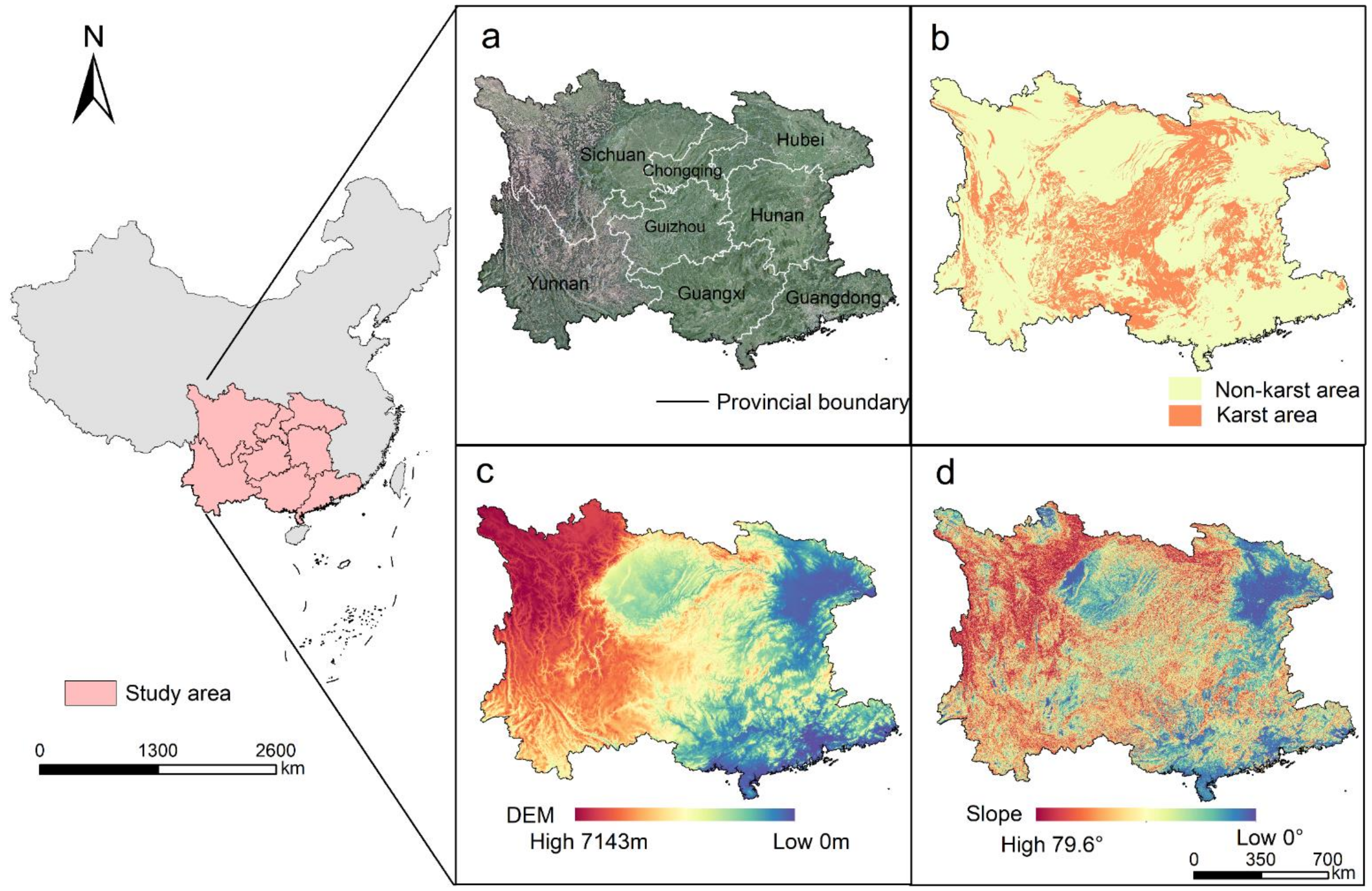
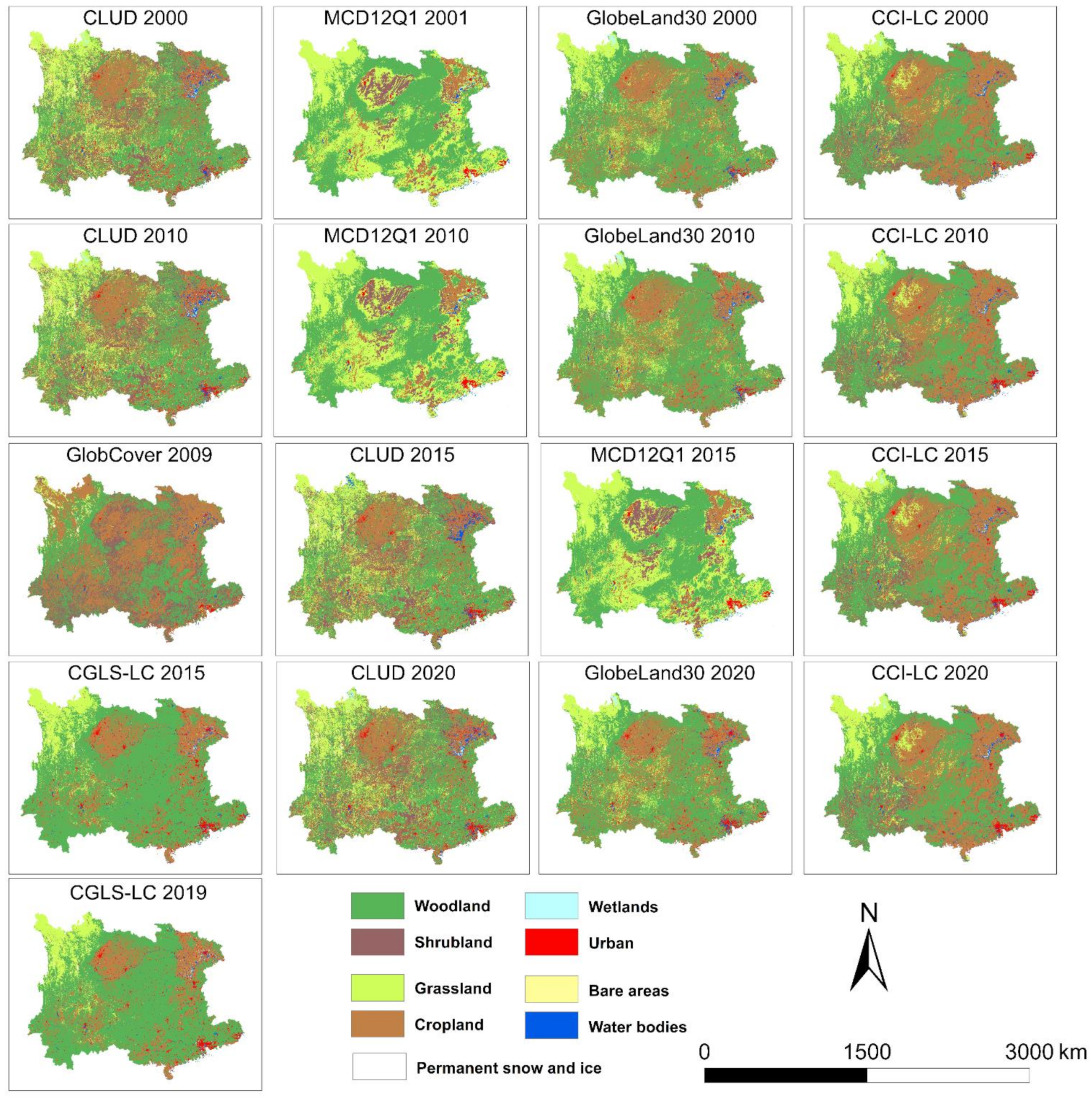
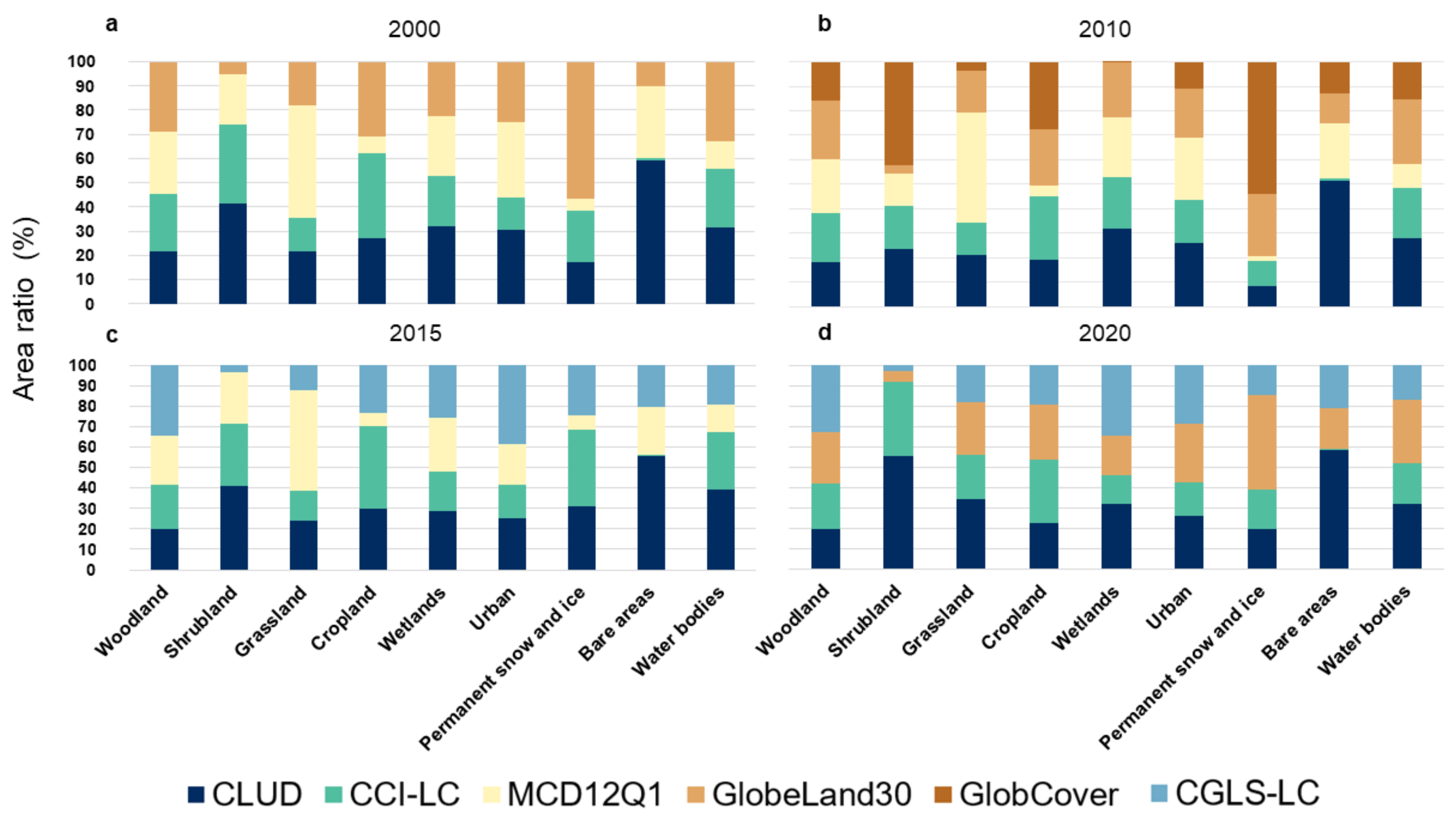
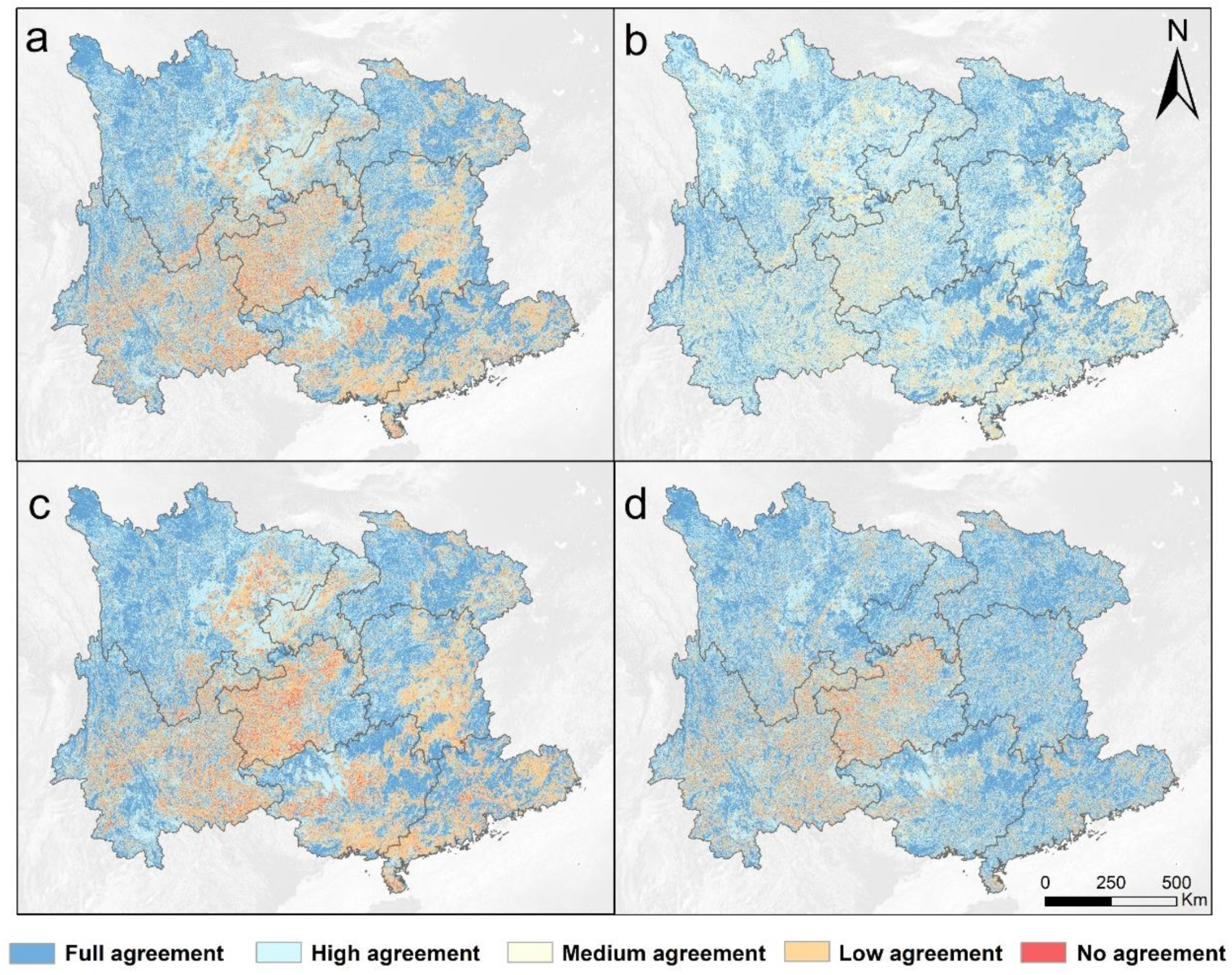
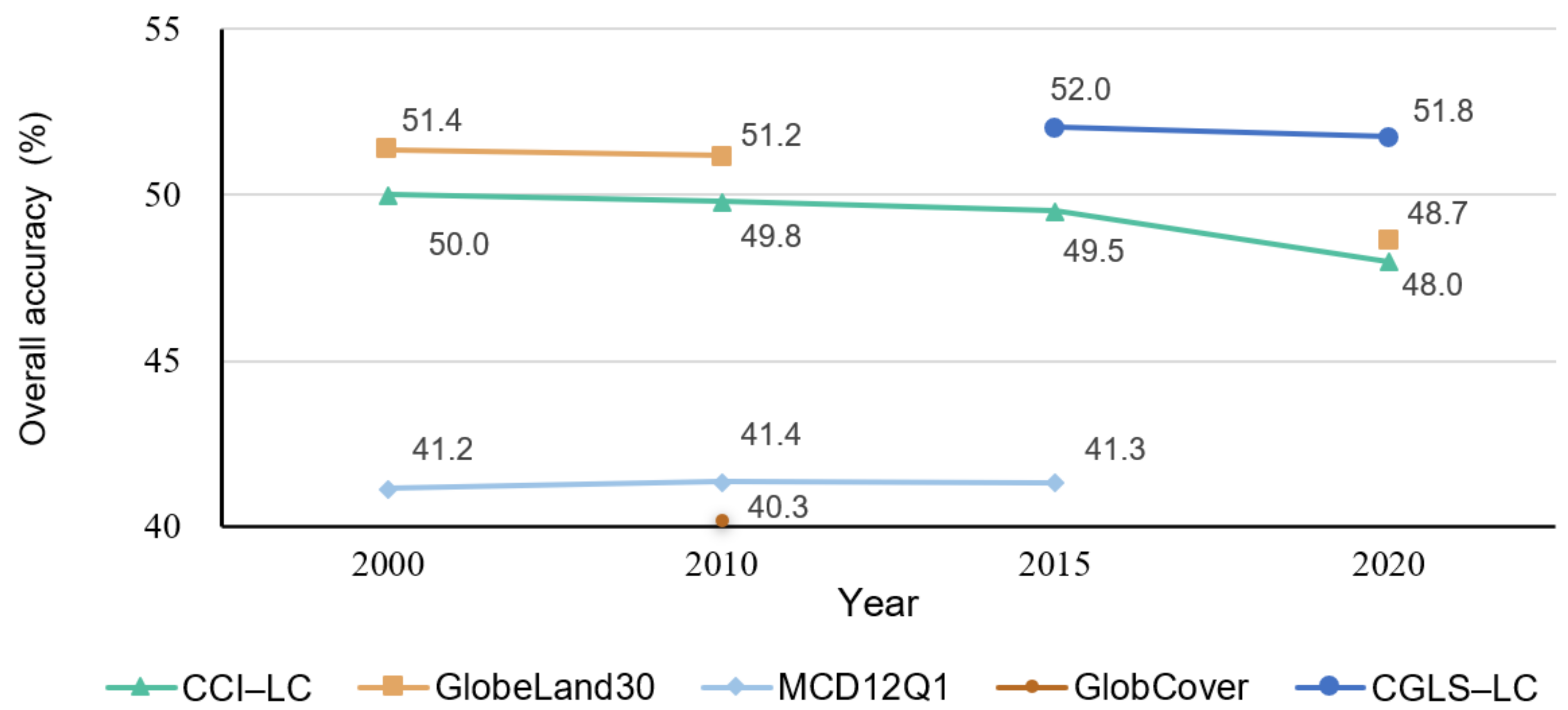
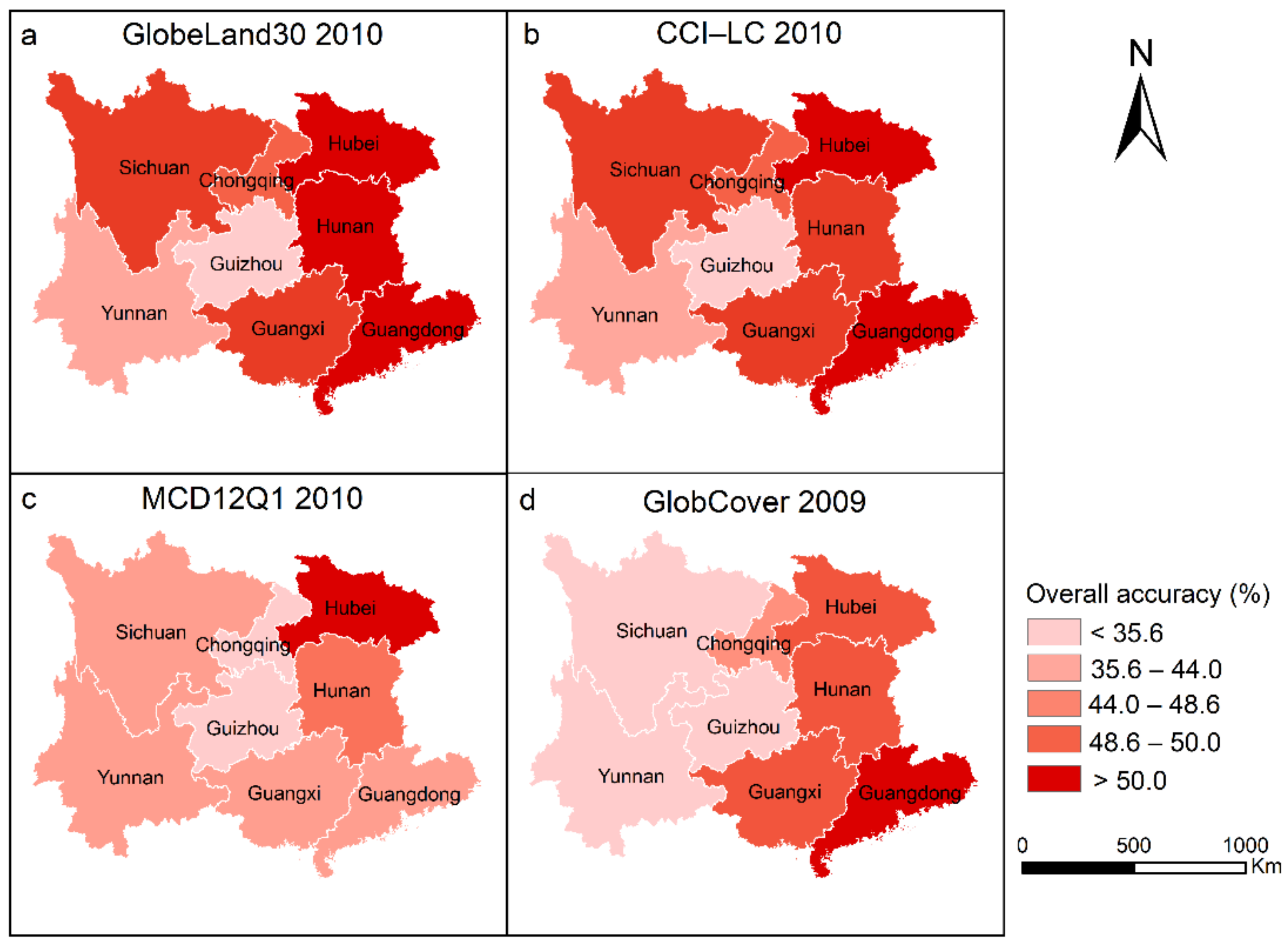
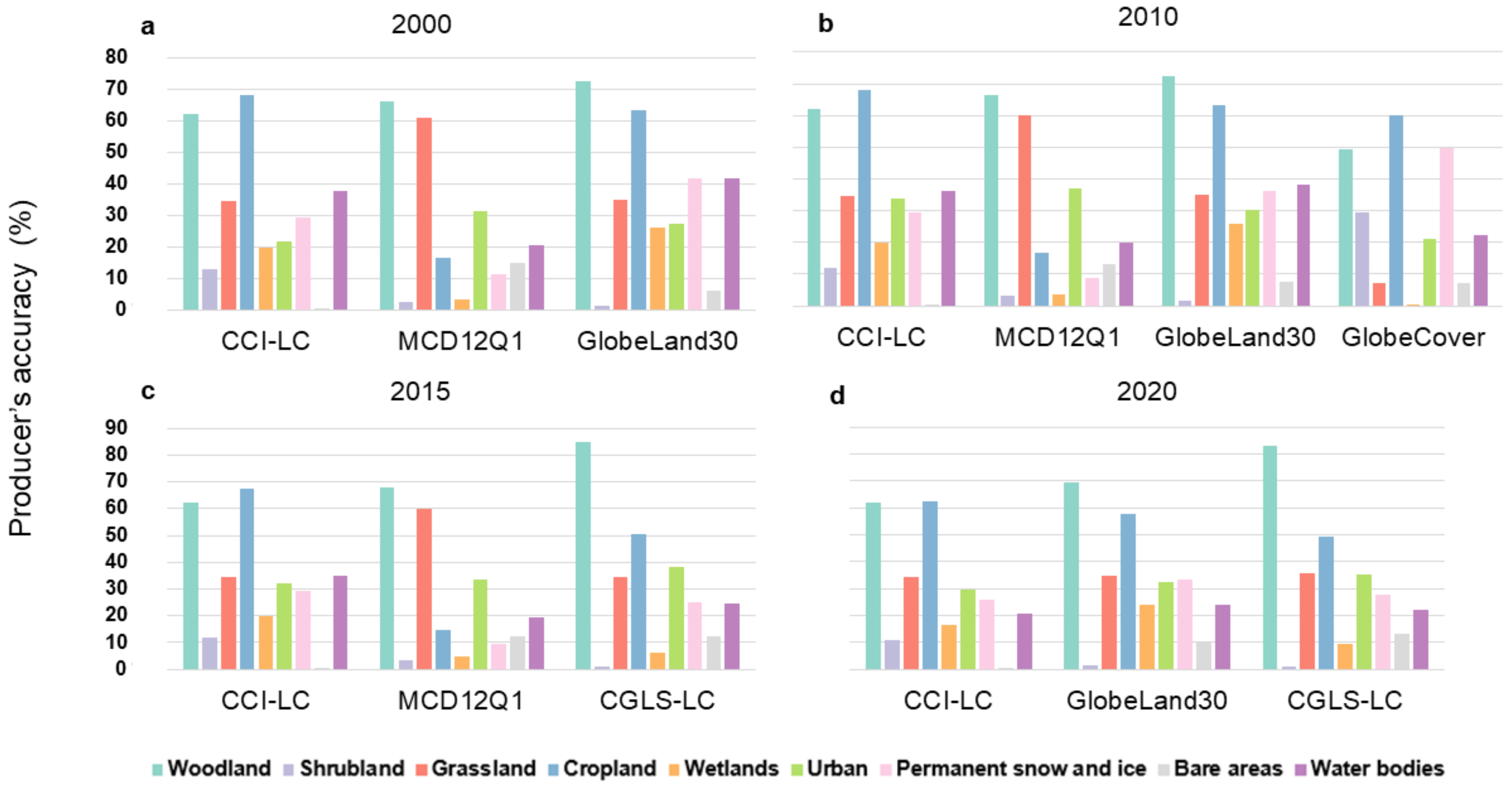
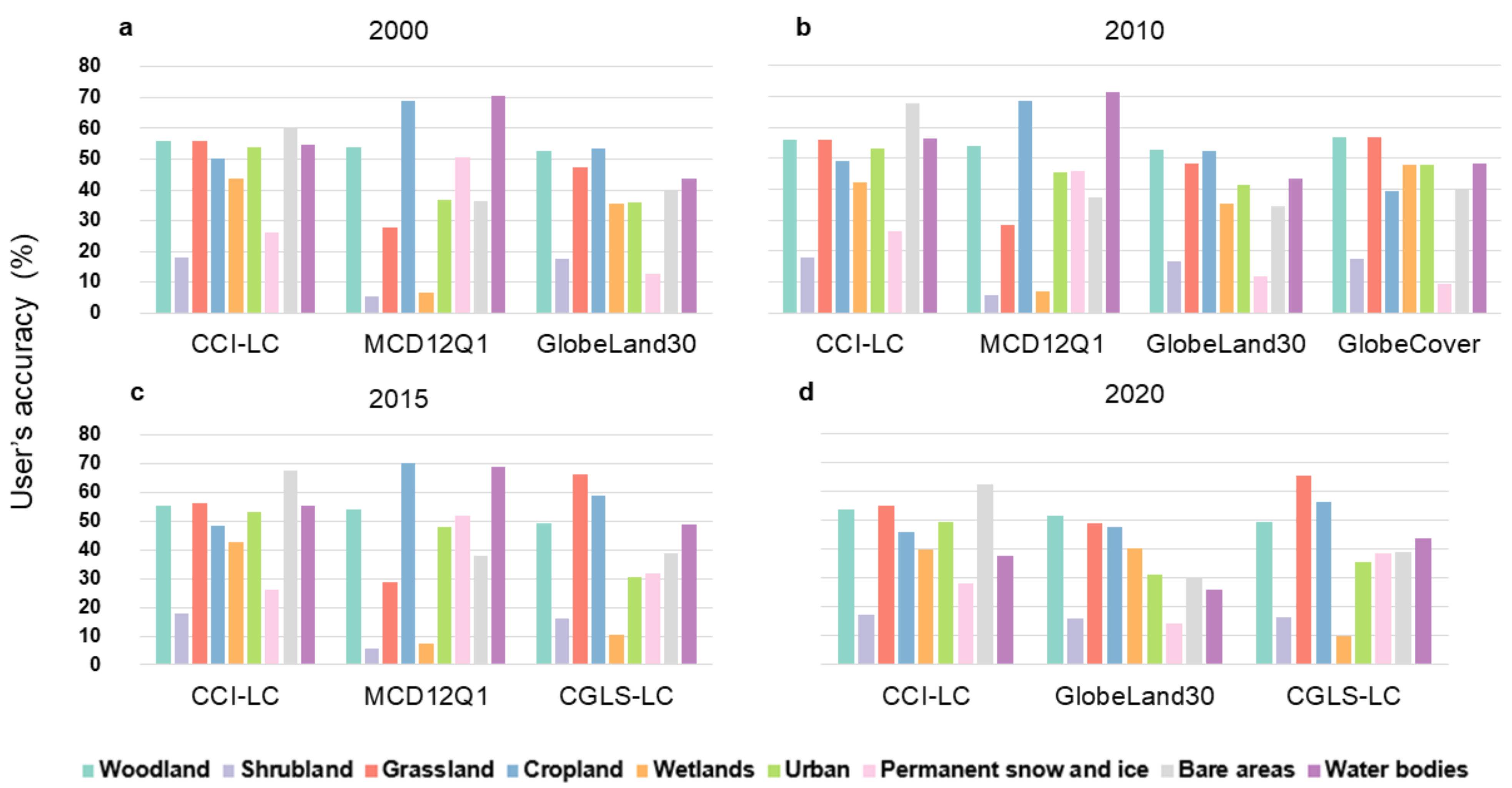
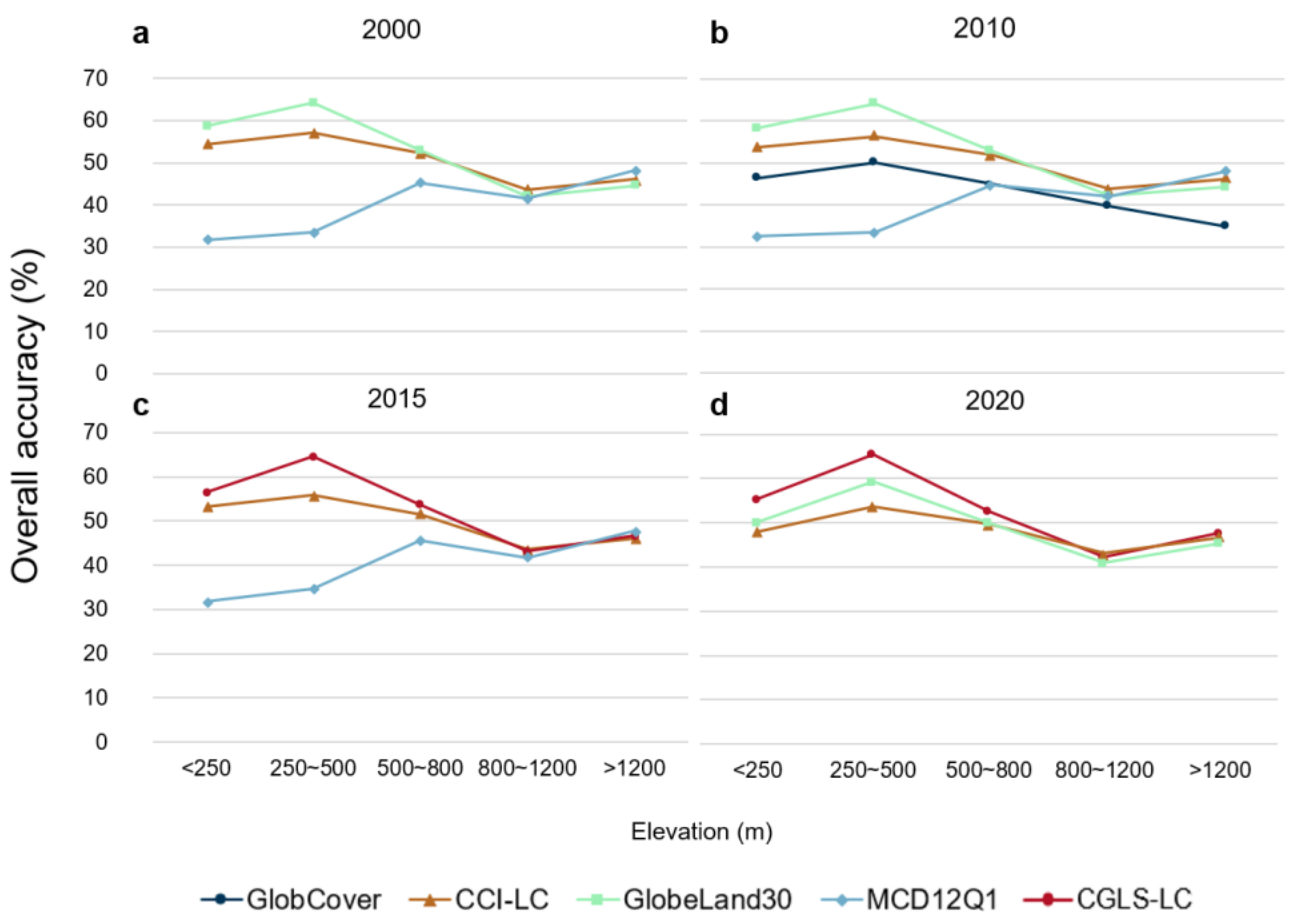

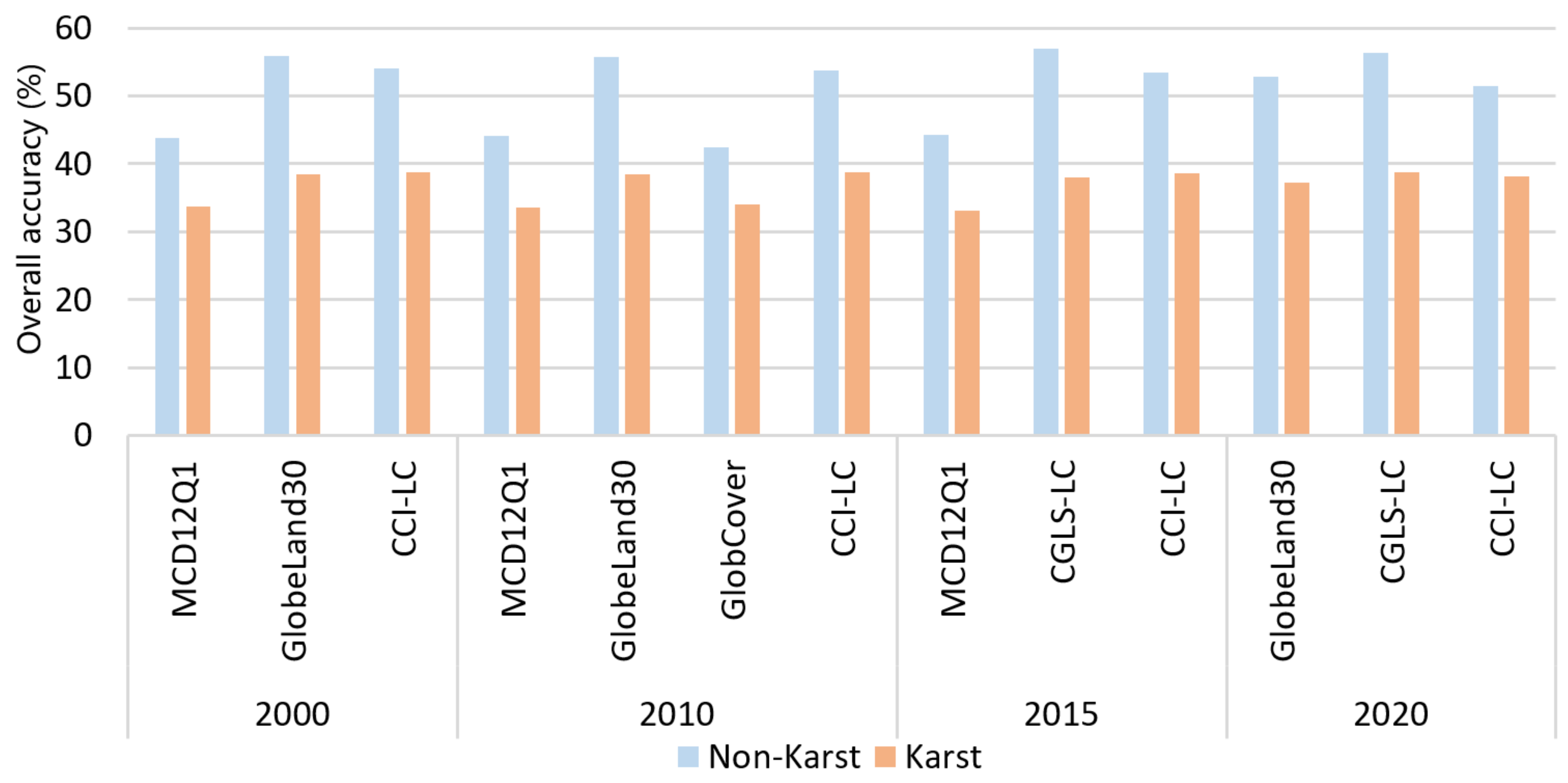
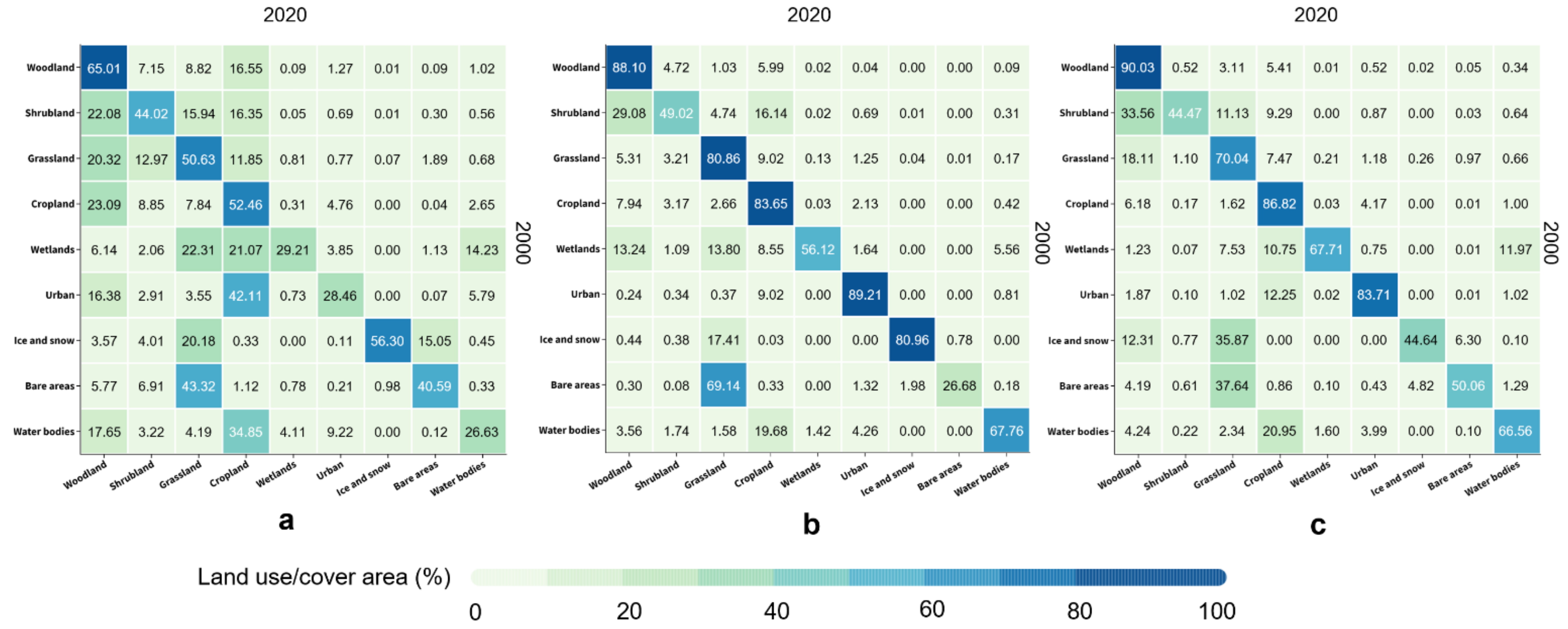

| CCI-LC | CCI LC 2020 | MCD12Q1 | GlobeLand30 | GlobCover | CGLS-LC | |
|---|---|---|---|---|---|---|
| Organization | ESA | ESA | NASA | NGCC | ESA | VITO |
| Spatial Range | Global | Global | Global | Global | Global | Global |
| Sensors | MERIS FR/SPOT VGT | PROBA-V S3-OLCI | MODIS | Landsat TM/ETM+/OLI, HJ-1/GF-1 | MERIS FR | PROBA-V |
| Period of Data Acquisition | 2000, 2010, 2015 | 2020 | 2001, 2010, 2015 | 2000, 2010, 2020 | 2009 | 2015, 2019 |
| Spatial Resolution | 300 m | 300 m | 500 m | 30 m | 300 m | 100 m |
| Classification Method | Supervised and Unsupervised Change Detection | Supervised and Unsupervised Change Detection | Supervised Classification | POK-Based | Supervised and Unsupervised Classification | Supervised Classification |
| Classification Scheme | LCCS 22 classes | LCCS 22 classes | IGBP 17 classes | 10 classes | LCCS 22 classes | LCCS 22 classes |
| Overall Accuracy | 70–75% | 70.5% | 70–80% | 80–85% | 60–70% | 80–85% |
| CLUD | CCI-LC | MCD12Q1 | GlobeLand30 | GlobCover | CGLS-LC | |
|---|---|---|---|---|---|---|
| Woodland | Woodland, sparse woodland, other woodland | Tree or shrub cover, tree cover, broadleaved, evergreen, deciduous, flooded, mixed leaf type, mosaic tree, shrub | Evergreen needleleaf forests, evergreen broadleaf forests, deciduous needleleaf forests, deciduous broadleaf forests, mixed forests, woody savannas | Forest | Broadleaved evergreen and/or semideciduous forest, broadleaved deciduous forest, needle leaved deciduous or evergreen forest, mixed broadleaved and needle leaved forest, broadleaved forest regularly flooded | Closed forest, evergreen needle leaf/broad leaf, deciduous needle leaf/broad leaf, mixed, open forest, evergreen needle leaf/broad leaf, deciduous needle leaf/broad leaf, mixed |
| Shrubland | Shrubland | Shrubland, evergreen shrubland, deciduous shrubland, sparse vegetation, sparse shrub, mosaic herbaceous cover, mosaic natural vegetation | Closed shrublands, open shrublands | Shrubland | Mosaic vegetation, mosaic forest–shrubland, closed to open (>15%) shrubland, sparse (>15%) vegetation | Shrubs |
| Grassland | High-coverage grassland, medium-coverage grassland, low-coverage grassland | Herbaceous cover, grassland, sparse herbaceous cover | Savannas, grasslands | Grassland | Mosaic grassland, closed to open (>15%) grassland | Herbaceous vegetation |
| Cropland | Paddy, dryland | Rainfed croplands, irrigated or post-flooding, mosaic cropland | Croplands | Cropland | Post-flooding or irrigated croplands, rainfed croplands, mosaic cropland | Cultivated and managed vegetation/agriculture |
| Wetlands | Tidal flats, beaches, marshes | fresh/saline/brackish water | Permanent wetlands | Wetlands | Closed to open (>15%) vegetation on regularly flooded or waterlogged soil—fresh, brackish, or saline water | Herbaceous wetland |
| Urban | Urban land, other construction land | Urban areas | Urban and built-up lands | Artificial surface | Artificial surfaces and associated areas | Urban/built-up |
| Permanent snow and ice | Permanent snow and ice | Permanent snow and ice | Permanent snow and ice | Glaciers and permanent snow | Permanent snow and ice | Snow and ice |
| Bare areas | Sandy land, Gobi, saline land, bare land, bare rock land, other unused land | Bare areas, unconsolidated bare areas, lichens and mosses | Barren | Tundra, bare areas | Bare areas | Bare/sparse vegetation |
| Waterbodies | Canals, lakes, reservoirs, ponds, oceans | Waterbodies | Waterbodies | Waterbodies | Waterbodies | Permanent waterbodies |
Publisher’s Note: MDPI stays neutral with regard to jurisdictional claims in published maps and institutional affiliations. |
© 2022 by the authors. Licensee MDPI, Basel, Switzerland. This article is an open access article distributed under the terms and conditions of the Creative Commons Attribution (CC BY) license (https://creativecommons.org/licenses/by/4.0/).
Share and Cite
Liu, P.; Pei, J.; Guo, H.; Tian, H.; Fang, H.; Wang, L. Evaluating the Accuracy and Spatial Agreement of Five Global Land Cover Datasets in the Ecologically Vulnerable South China Karst. Remote Sens. 2022, 14, 3090. https://doi.org/10.3390/rs14133090
Liu P, Pei J, Guo H, Tian H, Fang H, Wang L. Evaluating the Accuracy and Spatial Agreement of Five Global Land Cover Datasets in the Ecologically Vulnerable South China Karst. Remote Sensing. 2022; 14(13):3090. https://doi.org/10.3390/rs14133090
Chicago/Turabian StyleLiu, Pengyu, Jie Pei, Han Guo, Haifeng Tian, Huajun Fang, and Li Wang. 2022. "Evaluating the Accuracy and Spatial Agreement of Five Global Land Cover Datasets in the Ecologically Vulnerable South China Karst" Remote Sensing 14, no. 13: 3090. https://doi.org/10.3390/rs14133090
APA StyleLiu, P., Pei, J., Guo, H., Tian, H., Fang, H., & Wang, L. (2022). Evaluating the Accuracy and Spatial Agreement of Five Global Land Cover Datasets in the Ecologically Vulnerable South China Karst. Remote Sensing, 14(13), 3090. https://doi.org/10.3390/rs14133090








